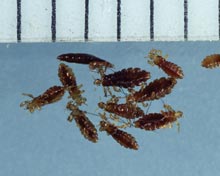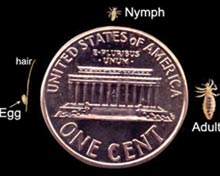
Iowa Department of Public Health

Iowa Department of Public Health
Head Louse
General Description
The head louse is approximately one-tenth of an inch to one-eighth of an inch long, pale white in color, and is
most commonly found in the hair above the ears and on the back of the neck. The earliest and most common
symptom of head lice infestation is itching around the ears and at the nape of the neck. Head lice can be passed
from person to person through direct contact. They also can be transferred indirectly with clothing and personal
items, for example, when infested hair brushes or combs are shared or when infested bedding, towels or shower
caps are shared. The life span of an adult louse on a host ranges up to 30 days. Off the host, an adult head louse
can live up to four days. Young lice or “nits” will remain alive off the host for up to 10 days, but will not hatch at or
below room temperature (68° F).
General Control
Special fine-tooth combs (Nit combs) are readily available and can be used to scrape nits and lice off the hair
shaft. Both prescription and over-the-counter remedies are effective in treating head lice. A product’s label should
be thoroughly read and followed to prevent overexposure. It is also important that pregnant women and infants
be treated under the direction of a physician because of concerns about potentially adverse effects. Fumigating
rooms and using insecticidal sprays on furniture and carpets are not recommended to kill head lice; thorough
vacuuming of houses and rooms inhabited by infested persons is sufficient. Exposing lice and nits to
temperatures above 125° F for 10 minutes will kill them. Most personal articles of clothing and bedding can be
disinfested by machine washing in hot water and drying for at least 20 minutes using the dryer’s hot cycle.









